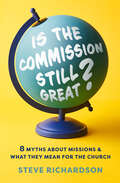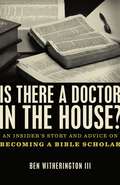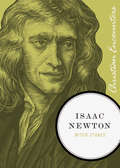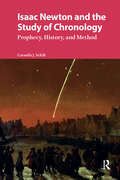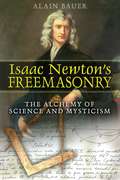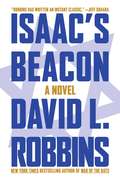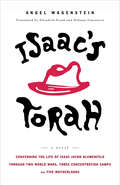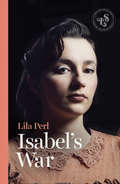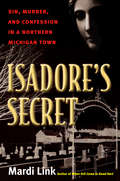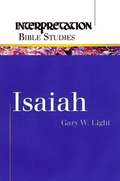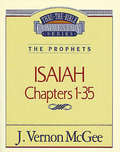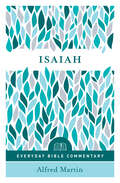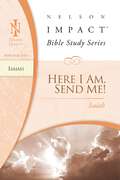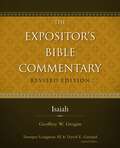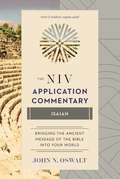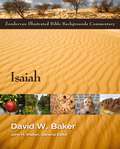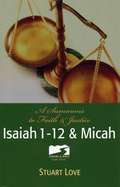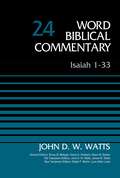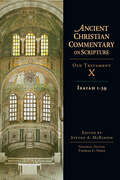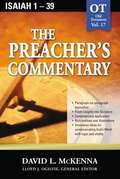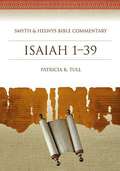- Table View
- List View
Is the Commission Still Great?: 8 Myths about Missions and What They Mean for the Church
by Steve RichardsonDismantling the Myths that Obscure God&’s Great Plan The primary mission of the church is to glorify God by blessing all peoples of the world through the gospel of Jesus Christ. The Great Commission&’s task of global disciple-making is the most ambitious project ever undertaken. Given the scale and complexity of global missions, it&’s no wonder that misconceptions abound, even among invested, godly people.Questions and skepticism about missions arise from both outside and inside the church. Is missions an outdated idea? Do missionaries do more harm than good? Are we succeeding or failing? Is it time for global believers to do the job in their own countries with minimal Western involvement? We don&’t need to fear questions like these. But we do need to seek—and find—solid, biblical answers.Is the Commission Still Great? dismantles the myths that obscure God&’s beautiful plan to make disciples of all nations. Misperceptions discourage God&’s people from joyfully participating with Him in reaching the world. Yet, deepening our understanding of the call to missions restores perspective and motivates us to participate in God&’s grand design.Author and missionary kid Steve Richardson uses stories from Scripture, history, and his own ministry experience to impart timely lessons on modern missions. Richardson also draws from the wisdom of field missionaries, sending agencies, pastors, and church members to address this all-important endeavor. Each chapter finishes with thought-provoking questions to facilitate purposeful discussion in families and small groups. Is the Commission Still Great? will equip followers of Christ to be participants—not spectators—in the redemption of the world.
Is the Commission Still Great?: 8 Myths about Missions and What They Mean for the Church
by Steve RichardsonDismantling the Myths that Obscure God&’s Great Plan The primary mission of the church is to glorify God by blessing all peoples of the world through the gospel of Jesus Christ. The Great Commission&’s task of global disciple-making is the most ambitious project ever undertaken. Given the scale and complexity of global missions, it&’s no wonder that misconceptions abound, even among invested, godly people.Questions and skepticism about missions arise from both outside and inside the church. Is missions an outdated idea? Do missionaries do more harm than good? Are we succeeding or failing? Is it time for global believers to do the job in their own countries with minimal Western involvement? We don&’t need to fear questions like these. But we do need to seek—and find—solid, biblical answers.Is the Commission Still Great? dismantles the myths that obscure God&’s beautiful plan to make disciples of all nations. Misperceptions discourage God&’s people from joyfully participating with Him in reaching the world. Yet, deepening our understanding of the call to missions restores perspective and motivates us to participate in God&’s grand design.Author and missionary kid Steve Richardson uses stories from Scripture, history, and his own ministry experience to impart timely lessons on modern missions. Richardson also draws from the wisdom of field missionaries, sending agencies, pastors, and church members to address this all-important endeavor. Each chapter finishes with thought-provoking questions to facilitate purposeful discussion in families and small groups. Is the Commission Still Great? will equip followers of Christ to be participants—not spectators—in the redemption of the world.
Is there a Doctor in the House?: An Insider’s Story and Advice on becoming a Bible Scholar
by Ben Witherington IiiMany people assume that becoming a serious student of the Bible merely requires diligent study of English Bible translations, but biblical scholarship is much more complex. Is There a Doctor in the House? demonstrates what it takes to be a responsible Bible teacher, a well-published Bible scholar, or even a good student of the Bible: exacting knowledge of biblical languages and the languages in which most Bible scholarship is done; a love for history and archaeology; a sensitivity for literature and literary genres; and an understanding of theology, ethics, and ancient religions and philosophies. In one sense, every Bible scholar has to be a general practitioner—the foundation of biblical scholarship must be both broad and well built. Through the course of this book, Witherington invites would-be Bible experts to pursue excellence for the sake of the Bible’s world-altering message. From students considering a Ph.D. to lay Bible teachers, Is There a Doctor in the House? promises to be an informative, engaging, and often humorous resource.
Isaac Newton (Christian Encounters Series)
by Mitch StokesChristian Encounters, a series of biographies from Thomas Nelson Publishers, highlights important lives from all ages and areas of the Church. Some are familiar faces. Others are unexpected guests. But all, through their relationships, struggles, prayers, and desires, uniquely illuminate our shared experience.As an inventor, astronomer, physicist, and philosopher, Isaac Newton forever changed the way we see and understand the world. At one point, he was the world's leading authority in mathematics, optics, and alchemy. And surprisingly he wrote more about faith and religion than on all of these subjects combined. But his single-minded focus on knowledge and discovery was a great detriment to his health. Newton suffered from fits of mania, insomnia, depression, a nervous breakdown, and even mercury poisoning. Yet from all of his suffering came great gain. Newton saw the scientific world not as a way to refute theology, but as a way to explain it. He believed that all of creation was mandated and set in motion by God and that it was simply waiting to be "discovered" by man. Because of his diligence in both scientific and biblical study, Newton had a tremendous impact on religious thought that is still evident today.
Isaac Newton and the Study of Chronology: Prophecy, History, and Method
by Cornelis SchiltIsaac Newton (1642-1727) is best known for his natural philosophical and mathematical works. Yet he devoted ample time to the study of ancient chronology, resulting in the posthumously published The Chronology of Ancient Kingdoms Amended (1728). Here, Newton attempted to show how the antiquity of Greece, Egypt, Assyria, Persia, and other Mediterranean nations could be reinterpreted to fit the timespan allowed for by Scripture. As the hundreds of books from his library and the thousands of manuscript pages devoted to the topic show, the Chronology was long in the making. This volume provides the first comprehensive analysis of the genesis and evolution of Newton’s studies of ancient history and demonstrates how these emerged from that other major scholarly project of his, the interpretation of the apocalyptic prophecies in Scripture. A careful study of Newton's reading, note-taking, writing, and ordering practices provides the key to unravelling and reconstructing the chronology of Newton’s chronological studies, bringing to light writings hitherto hidden in the archives.
Isaac Newton's Freemasonry: The Alchemy of Science and Mysticism
by Alain BauerAn exploration of how modern Freemasonry enabled Isaac Newton and his like-minded contemporaries to flourish • Shows that Freemasonry, as a mystical order, was conceived as something new--an amalgam of alchemy and science that had little to do with operative Freemasonry • Reveals how Newton and his friends crafted this “speculative,” symbolic Freemasonry as a model for the future of England • Connects Rosslyn Chapel, Henry Sinclair, and the Invisible College to Newton and his role in 17th-century Freemasonry Freemasonry, as a fraternal order of scientists and philosophers, emerged in the 17th century and represented something new--an amalgam of alchemy and science that allowed the creative genius of Isaac Newton and his contemporaries to flourish. In Isaac Newton’s Freemasonry, Alain Bauer presents the swirl of historical, sociological, and religious influences that sparked the spiritual ferment and transformation of that time. His research shows that Freemasonry represented a crossroads between science and spirituality and became the vehicle for promoting spiritual and intellectual egalitarianism. Isaac Newton was seminal in the “invention” of this new form of Freemasonry, which allowed Newton and other like-minded associates to free themselves of the church’s monopoly on the intellectual milieu of the time. This form of Freemasonry created an ideological blueprint that sought to move England beyond the civil wars generated by its religious conflicts to a society with scientific progress as its foundation and standard. The “science” of these men was rooted in the Hermetic tradition and included alchemy and even elements of magic. Yet, in contrast to the endless reinterpretations of church doctrine that fueled the conflicts ravaging England, this new society of Accepted Freemasons provided an intellectual haven and creative crucible for scientific and political progress. This book reveals the connections of Rosslyn Chapel, Henry Sinclair, and the Invisible College to Newton’s role in 17th-century Freemasonry and opens unexplored trails into the history of Freemasonry in Europe.
Isaac's Beacon: A Novel (The Promised Wars #1)
by David L. RobbinsIn the tradition of epic novels like Exodus and Cast a Giant Shadow, Isaac&’s Beacon is a sweeping historical tale based on the real events of Israel&’s founding—bringing alive the power and complexities of the birth of the Jewish state out of the ashes of the Holocaust. Bestselling author David L. Robbins, called &“the Homer of World War II,&” turns his mastery of the historical novel to another defining moment of the twentieth century: the birth of the state of Israel. Isaac&’s Beacon is a small, vulnerable kibbutz on the edge of the Negev. Here, the lives of three memorable characters—an Irgun fighter, a young woman farmer, and an American journalist—collide to shape an epic narrative of love, loss, violence, and courage. Deeply researched and closely based on actual events, Isaac&’s Beacon is the first in a series of Robbins&’s novels which will explore the tumultuous, complex history and lasting impact of Israel&’s creation.
Isaac's Torah: A Novel
by Angel WagensteinThis novel is the saga in five parts of Isaac Jacob Blumenfeld, who grows up in Kolodetz, a small town near Lvov, which, when he&’s a boy, belongs to the Hapsburg Empire, but which subsequently belongs to Poland, Soviet Russia, Germany, and then Russia again. Isaac survives the absurdity and horror of Eastern Europe during the 20th century by pretending to be a fool. If this is an old Jewish art, then Isaac is a consummate artist. He plays the fool all his life, from his boyhood in Kolodetz shetl to the time when he is an accused war criminal in a Gulag in Siberia. Inseparable from Isaac&’s life and story are the Yiddish jokes and fables of Kolodetz. These and the counsel of his dear friend, the rabbi and chair of the atheist club in Kolodetz, Shmuel Ben David, sustain Isaac through two world wars, three concentration camps, and five motherlands. The book puts on record, with full art, what is perhaps the central story of the last one hundred years. It is a wise book.
Isabel's War
by Lila PerlIn a stunning new novel completed just before her death in 2013, award-winning author Lila Perl introduces us to Isabel Brandt, a French-phrase-dropping twelve-year-old New Yorker who's more interested in boys and bobbing her nose than the distant war across the Pacific--the one her parents keep reminding her to care more about. Things change when Helga, the beautiful niece of her parent's best friends, comes to live with Isabel and her family. Helga is everything Isabel's not--cool, blonde, and vaguely aloof. She's also a German war refugee, with a past that gives a growing Isabel something more important to think about than boys and her own looks. Set in the Bronx during World War II, Isabel's War is a beautiful evocation of New York in the 1940s and of a girl's growing awareness of the world around her.Lila Perl, the daughter of Russian immigrants fleeing anti-Semitism, published over sixty volumes of fiction and nonfiction for young readers during her long and distinguished career. In addition to the beloved Fat Glenda series, Perl twice received American Library Association Notable awards for nonfiction and was a recipient of the Sidney Taylor Award for Four Perfect Pebbles: A Holocaust Story. She died in 2013 at the age of ninety-two. Isabel's War and its completed sequel, Lilli's Quest, were her final works.
Isadore's Secret
by Mardi LinkA gripping account of the mysterious disappearance of a young nun in a northern Michigan town and the national controversy that followed when she turned up dead and buried in the basement of the church
Isaiah
by Gary W. LightMany of the verses of Isaiah are familiar to us as beloved passages we read and sing each Christmas and Easter season. But Isaiah is more than just a holiday reading. Isaiah speaks of God's relationship to the prophet, the people, the kings, and the servant. Isaiah's message invites us to explore God's personal character and develop a deeper understanding of the living God, the Holy One of Israel. Interpretation Bible Studies (IBS) offers solid biblical content in a creative study format. Forged in the tradition of the celebrated Interpretation commentary series, IBS makes the same depth of biblical insight available in a dynamic, flexible, and user-friendly resource. Designed for adults and older youth, IBS can be used in small groups, in church school classes, in large group presentations, or in personal study.
Isaiah II (Thru the Bible #22)
by Vernon McgeeRadio messages from J. Vernon McGee delighted and enthralled listeners for years with simple, straightforward language and clear understanding of the Scripture. Now enjoy his personable, yet scholarly, style in a 60-volume set of commentaries that takes you from Genesis to Revelation with new understanding and insight. Each volume includes introductory sections, detailed outlines and a thorough, paragraph-by-paragraph discussion of the text. A great choice for pastors - and even better choice for the average Bible reader and student! Very affordable in a size that can go anywhere, it's available as a complete 60-volume series, in Old Testament or New Testament sets, or individually.
Isaiah & Jeremiah- Jensen Bible Self Study Guide (Jensen Bible Self-Study Guide Series)
by Irving L. JensenIsaiah has been called the "evangelistic prophet," because he taught about how Christ the Messiah would come to redeem the lost. Jeremiah has been called the "weeping prophet," because he wept over the continuing sin and coming destruction of Jerusalem. This self-study guide examines prophecies in Isaiah and Jeremiah regarding the Person and work of Christ, and it discusses the Tribulation, the kingdom, God's greatness, and His program for peace.The books in the Jensen Bible Self-Study Guide series are designed to provide you with a broader understanding of God&’s Word. Offering historical context and background, author information, charts, and other helps, these books will equip you with a comprehensive reference tool you&’ll return to often. Each study includes an opportunity for analysis, response, and further study in a response-oriented format. The thirty-nine books in this series are suitable for both personal and group use.
Isaiah & Jeremiah- Jensen Bible Self Study Guide (Jensen Bible Self-Study Guide Series)
by Irving L. JensenIsaiah has been called the "evangelistic prophet," because he taught about how Christ the Messiah would come to redeem the lost. Jeremiah has been called the "weeping prophet," because he wept over the continuing sin and coming destruction of Jerusalem. This self-study guide examines prophecies in Isaiah and Jeremiah regarding the Person and work of Christ, and it discusses the Tribulation, the kingdom, God's greatness, and His program for peace.The books in the Jensen Bible Self-Study Guide series are designed to provide you with a broader understanding of God&’s Word. Offering historical context and background, author information, charts, and other helps, these books will equip you with a comprehensive reference tool you&’ll return to often. Each study includes an opportunity for analysis, response, and further study in a response-oriented format. The thirty-nine books in this series are suitable for both personal and group use.
Isaiah (Everyday Bible Commentary)
by Alfred MartinProphecy can be confusing. In a book like Isaiah, historical events are presented out of order and right next to future prophecies without obvious distinctions between the two. Plus, it&’s full of strange symbols like the sprout that grows out of the root of Jesse. What we need is a guide—someone who will tell us what&’s historic and what&’s prophetic, and explain all the strange symbolism clearly and simply. This is what the best preachers do, but you don&’t have to wait until Sunday&’s sermon. Encounter the beautiful depth of Isaiah through an enlightening commentary from Alfred Martin that&’s both straightforward and insightful. You&’ll gain:Important historical background Insights from the original languageExplanations of the prophetic symbols And more!You don&’t have to go to seminary to encounter God in exciting, new ways through His Word. Discover how much more enjoyable your personal study will be with understandable, quality Bible commentary for everyday life.
Isaiah (Everyday Bible Commentary)
by Alfred MartinProphecy can be confusing. In a book like Isaiah, historical events are presented out of order and right next to future prophecies without obvious distinctions between the two. Plus, it&’s full of strange symbols like the sprout that grows out of the root of Jesse. What we need is a guide—someone who will tell us what&’s historic and what&’s prophetic, and explain all the strange symbolism clearly and simply. This is what the best preachers do, but you don&’t have to wait until Sunday&’s sermon. Encounter the beautiful depth of Isaiah through an enlightening commentary from Alfred Martin that&’s both straightforward and insightful. You&’ll gain:Important historical background Insights from the original languageExplanations of the prophetic symbols And more!You don&’t have to go to seminary to encounter God in exciting, new ways through His Word. Discover how much more enjoyable your personal study will be with understandable, quality Bible commentary for everyday life.
Isaiah (Nelson Impact Bible Study Guide)
by Thomas NelsonThe Nelson Impact Bible Study series will introduce in-depth Bible study to Christian laypeople. Each book will help readers experience the true meaning of the messages in the book of Genesis, and in turn, empower the reader to truly make a difference in the world for Christ.Designed for individual or group study, the study guide will provide a foundation for Bible study and encourage the reader to return to the Bible. All necessary background information will be given so that the reader needs only a Bible and the study guide. The messages will be thorough but easily understood and will be complimented by application questions to guide the readers into a deeper relationship with the Bible that will impact their lives with the gospel of Jesus Christ.Other study guides in the series include:1 Corinthians ISBN: 1418506192Exodus ISBN: 1418506168Genesis ISBN: 1418506087Isaiah ISBN: 1418506095John ISBN: 1418506109Mark ISBN: 1418506184Romans ISBN: 1418506117Ruth & Esther ISBN: 1418506176
Isaiah (The Expositor's Bible Commentary)
by Tremper Longman III David E. Garland Rev Geoffrey W. GroganContinuing a Gold Medallion Award-winning legacy, this completely revised edition of The Expositor’s Bible Commentary series puts world-class biblical scholarship in your hands. Based on the original twelve-volume set that has become a staple in college and seminary libraries and pastors’ studies worldwide, this new thirteen-volume edition marshals the most current evangelical scholarship and resources. The thoroughly revised features consist of: • Comprehensive introductions • Short and precise bibliographies • Detailed outlines • Insightful expositions of passages and verses • Overviews of sections of Scripture to illuminate the big picture • Occasional reflections to give more detail on important issues • Notes on textual questions and special problems, placed close to the texts in question • Transliterations and translations of Hebrew and Greek words, enabling readers to understand even the more technical notes • A balanced and respectful approach toward marked differences of opinion
Isaiah (The NIV Application Commentary)
by John N. OswaltThe NIV Application Commentary helps you communicate and apply biblical text effectively in today's context.To bring the ancient messages of the Bible into today's world, each passage is treated in three sections:Original Meaning. Concise exegesis to help readers understand the original meaning of the biblical text in its historical, literary, and cultural context.Bridging Contexts. A bridge between the world of the Bible and the world of today, built by discerning what is timeless in the timely pages of the Bible.Contemporary Significance. This section identifies comparable situations to those faced in the Bible and explores relevant application of the biblical messages. The author alerts the readers of problems they may encounter when seeking to apply the passage and helps them think through the issues involved.This unique, award-winning commentary is the ideal resource for today's preachers, teachers, and serious students of the Bible, giving them the tools, ideas, and insights they need to communicate God's Word with the same powerful impact it had when it was first written.
Isaiah (Zondervan Illustrated Bible Backgrounds Commentary)
by John H. WaltonMany today find the Old Testament a closed book. The cultural issues seem insurmountable and we are easily baffled by that which seems obscure. Furthermore, without knowledge of the ancient culture we can easily impose our own culture on the text, potentially distorting it. This series invites you to enter the Old Testament with a company of guides, experts that will give new insights into these cherished writings. Features include • Over 2000 photographs, drawings, maps, diagrams and charts provide a visual feast that breathes fresh life into the text. <P><P>• Passage-by-passage commentary presents archaeological findings, historical explanations, geographic insights, notes on manners and customs, and more. • Analysis into the literature of the ancient Near East will open your eyes to new depths of understanding both familiar and unfamiliar passages. • Written by an international team of 30 specialists, all top scholars in background studies.
Isaiah 1-12 & Micah: A Summons to Faith & Justice
by Stuart LoveThis volume of the Streams of Mercy Study Series is devoted to two Old Testament prophetic writings: Isaiah 1-12 and Micah. Both prophets have unique qualities, but they also have much in common. In contrast, Isaiah was an urban prophet in Jerusalem and Micah was a rural prophet. However, both address similar issues. For instance, both condemn worship that was unrelated to ethical behavior. Many of the problems they faced, we still face today. Their answers still inspire us to greater faith and dedication today.Includes classroom suggestions and discussion questions and points at the end of each chapter.
Isaiah 1-33, Volume 24: Revised Edition (Word Biblical Commentary)
by Bruce M. Metzger Ralph P. Martin Lynn Allan Losie David Allen Hubbard Glenn W. Barker John D. Watts James W. WattsThe Word Biblical Commentary delivers the best in biblical scholarship, from the leading scholars of our day who share a commitment to Scripture as divine revelation. This series emphasizes a thorough analysis of textual, linguistic, structural, and theological evidence. The result is judicious and balanced insight into the meanings of the text in the framework of biblical theology. These widely acclaimed commentaries serve as exceptional resources for the professional theologian and instructor, the seminary or university student, the working minister, and everyone concerned with building theological understanding from a solid base of biblical scholarship. <P><P>Overview of Commentary Organization Introduction—covers issues pertaining to the whole book, including context, date, authorship, composition, interpretive issues, purpose, and theology.Each section of the commentary includes:Pericope Bibliography—a helpful resource containing the most important works that pertain to each particular pericope. Translation—the author’s own translation of the biblical text, reflecting the end result of exegesis and attending to Hebrew and Greek idiomatic usage of words, phrases, and tenses, yet in reasonably good English. <P>Notes—the author’s notes to the translation that address any textual variants, grammatical forms, syntactical constructions, basic meanings of words, and problems of translation.Form/Structure/Setting—a discussion of redaction, genre, sources, and tradition as they concern the origin of the pericope, its canonical form, and its relation to the biblical and extra-biblical contexts in order to illuminate the structure and character of the pericope. Rhetorical or compositional features important to understanding the passage are also introduced here.Comment—verse-by-verse interpretation of the text and dialogue with other interpreters, engaging with current opinion and scholarly research.Explanation—brings together all the results of the discussion in previous sections to expose the meaning and intention of the text at several levels: (1) within the context of the book itself; (2) its meaning in the OT or NT; (3) its place in the entire canon; (4) theological relevance to broader OT or NT issues.General Bibliography—occurring at the end of each volume, this extensive bibliography contains all sources used anywhere in the commentary.
Isaiah 1-39 (Ancient Christian Commentary on Scripture #10)
by Thomas C. OdenFor to us a child is born, to us a son is given; and the government will be upon his shoulder and his name shall be called "Wonderful Counselor, Mighty God, Everlasting Father, Prince of Peace." For the early church fathers the prophecy of Isaiah was not a compendium of Jewish history or theology but an announcement of the coming Messiah fulfilled in the life and ministry of Jesus of Nazareth. As such, the prophet's words were a rich source of theological reflection concerning their Lord and a vital aid in their defense against the objections of the Jews that Jesus was the promised Messiah. The interpretation of Jesus' ministry in light of Isaiah's prophecy was not a theological innovation on their part but rather a following of the path blazed by the New Testament writers and Jesus himself. Among passage-by-passage commentaries cited here are those by Eusebius of Caesarea, Jerome, Cyril of Alexandria, and Theodoret of Cyr, as well as one attributed to Basil of Caesarea. John Chrysostom preached a series of homilies on Isaiah of which most of those extant concern the first eight chapters, though Chrysostom frequently cites Isaiah in numerous homilies on other books. Augustine of Hippo, Gregory the Great, and Bede the Venerable frequently cite passages from Isaiah 1���39, as did many other fathers in defending the Christian faith from Jewish critics. In this Ancient Christian Commentary on Scripture volume, readers will find materials ranging from East to West and from the first through the eighth centuries, some appearing here in English translation for the first time. Within this treasure house are riches to illumine the mind and fire the heart.
Isaiah 1-39 (Preacher's Commentary, Volume #17)
by David L. MckennaThe author provides a chapter by chapter analysis of the first 39 chapters of the Old Testament book Isaiah and includes modern life applications as well as descriptions of historical events.
Isaiah 1-39 (Smyth & Helwys Bible Commentary)
by Patricia K. TullThe prophet Isaiah's influence extended from his long career in Jerusalem in the late 8th century BCE through Judah's exilic and Second Temple periods. Through the ages in both Judaism and Christianity, Isaiah's words have funded subsequent theological writings, liturgies, lectionaries, hymns, poetry, and art. Among early Christian writings, Isaiah was seen as "evangelist rather than prophet," foretelling Christ's birth, life, death, and resurrection-a view that continues to prevail today, though scholars have long argued that Isaiah addressed his own time and not, in the first instance, the distant future. Readers of Tull's engaging guide will come to understand Isaiah as visionary spokesperson of ancient Jerusalem's God in a critical moment in the history of western faith. They will learn about the paths the book traveled as it grew, absorbed new meanings, underwent reinterpretion, and emerged as Scripture for synagogues and churches. Preachers, teachers, and students will imagine afresh the connections between modern people and this ancient book ... the primary goal of the Smyth & Helwys Bible Commentary series is to make available serious, credible biblical scholarship in an accessible and less intimidating format.
